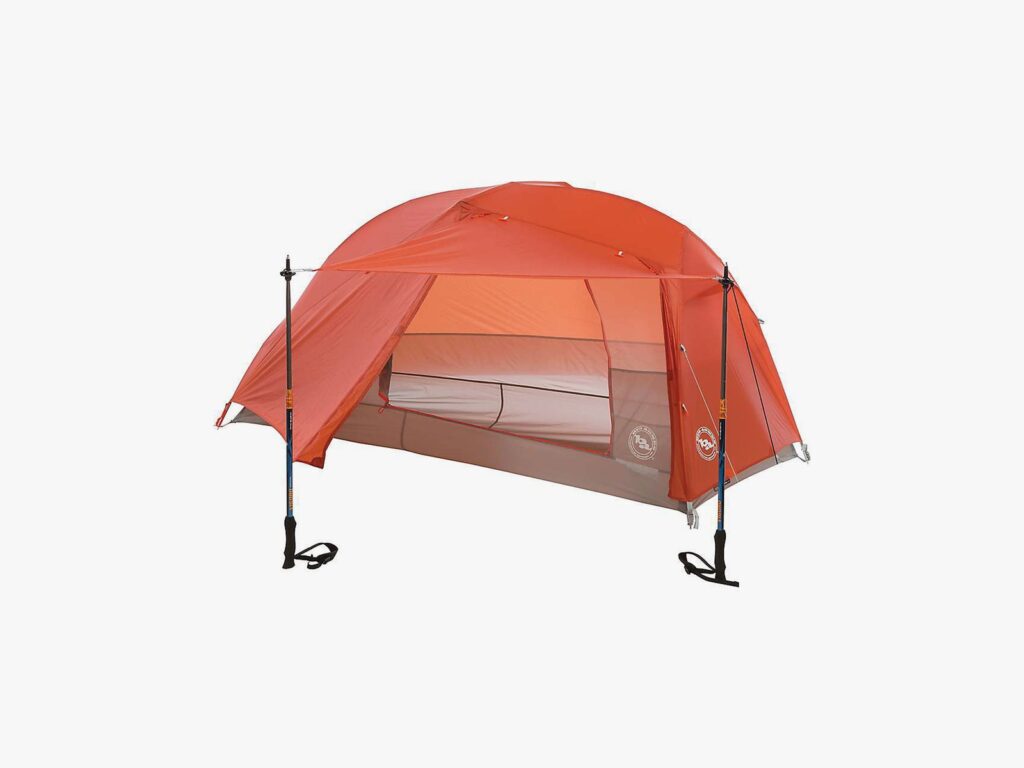Big Agnes Copper Spur UL1 Review: Small Tent, Big Winner
Clever storage, extremely light weight, and innovative buckles make this tent king of the hills….

Have you met Big Agnes? Maybe you’ve seen it perched high on a shelf at REI or lounging at a local campground. Not ringing a bell? It could be that you’re not enough of an ultralight camping nerd to have been introduced.
The Steamboat Springs, Colorado-based company makes some of the most bleeding-edge tents in the outdoors industry, but solely at the upper end of the market, aimed at hikers and backpackers who want the lightest, highest-performing tents and have the cash to pay for them. The Copper Spur series was updated in 2020 to include a vestibule that can be propped open with a pair of trekking poles like a porch awning. The latest model comes with lighter-weight fabric and a new tent buckle system for the guylines.
I gave it a multiweek test in California’s Death Valley and Arizona’s Grand Canyon, subjecting it to temperatures that varied from near-freezing to over 90 degrees Fahrenheit (32 degrees Celsius) and campsites from damp mountains and thicketed riverbanks to roasting desert floors. Keep reading to find out why, even with a couple of significant drawbacks, I recommend the Copper Spur UL1 as the best ultralight backpacking tent on the market. If you want the best, sometimes you have to pay for it.
Weighting Around
With a trail weight of 2 pounds, 2 ounces (about 960 grams), it’s at the cutting edge of ultra-lightweight tents. The Copper Spur is a fully freestanding tent, like the rival MSR Hubba Hubba NX, which means it doesn’t rely on guyline tie-outs—lines you attach to the ground or other objects—for core structural integrity. Ties-outs on the outer wall increase outer-tarp coverage and vestibule space, but they aren’t strictly necessary. There are semi-freestanding tents, like the Sea to Summit Alto TR1, which maintain most of their structure with poles but require a few tie-outs to take full shape. Freestanding tents like the Copper Spur typically flap around less in strong winds and can be completely pitched even when the ground is too firm to drive tent pegs into.
Because this tent is made with such a lightweight nylon fabric, you’ll need to take care with it. It’ll stand up to adventures, but if you carelessly drag it around, it’ll develop holes and tears. That’s the trade-off for shaving pounds off your load.
It’s a good idea to use a groundsheet or footprint to protect the tent floor from abrasion, and you’ll have to shell out $70 for one of those. There’s a bike-packing footprint for $80 that also covers the vestibule ground space, if you’d like a bit more coverage. While the groundsheet isn’t thick enough to resist punctures, I strongly recommend it for such a lightly built tent. It’s a lot cheaper to replace a groundsheet than to spring for an entire tent.
Pole Position
Setting up for a cold night at Mather Campground on the Grand Canyon’s South Rim, I was gingerly flexing a pole into its grommet on the interior wall when I heard a crack in one of the aluminum DAC Featherlite poles. Ultralight tents’ poles require care during assembly and disassembly, since they’re more fragile than standard tent poles. Yet in a whole career of climbing, camping, and hiking, I’d never broken a pole. Maybe the near-freezing temperature had made them more brittle than usual, but I’m only guessing. It was but a chip in the edge of the pole, but several days later on a similarly cold night the chipped piece finally shattered entirely.
That said, using the included pole splint, I kept the tent functional for the rest of my trip, and to its credit it survived some wickedly strong sunset wind gusts on the Boucher Trail. The tent handled high winds well in situations where other tents I’ve tested would’ve had me hanging on for dear life. That’s partly down to good tent design, and partly to good poles. Setting up the tent was quick and easy—certainly quicker than the Hubba Hubba NX—so even with the annoyance of the one broken pole, I was happy.
Repairs were also simple. After I returned home, Big Agnes fixed the broken pole for $4 per segment, plus shipping both ways, which is awfully cheap. The company also sent it back to me quickly. That’s one of the best manufacturer repair programs I’ve seen, and prices for other fixes are pretty cheap too. I plan to use the Copper Spur again in chilly temperatures in Idaho or Utah later this year. I’ll report back if my repaired poles suffer similar breakage again.
Buckling Down
Photograph: Big Agnes
In a market segment where every manufacturer is jockeying to differentiate themselves from the competition, one of Big Agnes’ major calling cards is its TipLok Tent Buckle. It’s a fancy name for a buckle system that joins the pole tips, outer wall (rain fly), footprint, and guyline tie-out loops via grommets and buckles, like those used on backpacks. Rather than tying guylines to tent pegs, as is traditional, everything just buckles together. Adjustments are easy, and there’s no complicated flopping around to attach a groundsheet under the tent. The buckles were clever when they worked, but coarse sand had a tendency to get stuck there, disabling them until I could fish out my knife and very carefully dislodge the grains.





